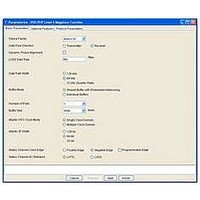IP-POSPHY4 Altera, IP-POSPHY4 Datasheet - Page 121

IP-POSPHY4
Manufacturer Part Number
IP-POSPHY4
Description
IP CORE - POS-PHY Level 4 SPI 4.2 Interface
Manufacturer
Altera
Type
MegaCorer
Datasheet
1.IP-POSPHY4.pdf
(144 pages)
Specifications of IP-POSPHY4
Software Application
IP CORE, Interface And Protocols, COMMUNICATION
Supported Families
Arria GX, Cyclone, HardCopy, Stratix
Core Architecture
FPGA
Core Sub-architecture
Arria, Cyclone, Stratix
Rohs Compliant
NA
Function
POS-PHY Level 4 Interface, Link-Layer/PHY Layer
License
Initial License
Lead Free Status / RoHS Status
na
Lead Free Status / RoHS Status
na
- Current page: 121 of 144
- Download datasheet (3Mb)
Pin Constraints
Board Design Configuration
Design for Testability
December 2010 Altera Corporation
f
f
f
1
The pinouts for the Stratix
clock input pins located on either the RXCLK_IN1n/p bank, or the RXCLK_IN2n/p bank.
For the Stratix IV, Stratix III and Stratix II device families, the dedicated LVDS clock
input pins are located on a minimum of two banks. You should try to keep all pins for
the receiver on the same bank. However, for Stratix III devices, if you cannot keep all
receiver pins in one I/O bank, use two adjacent banks. These LVDS banks require a
clean, filtered, power supply.
For detailed board layout guidelines, refer to
Guidelines.
For detailed board layout guidelines in Stratix III and Stratix II devices, refer to the
High-Speed Board Layout Guidelines
Stratix II Devices
For detailed board layout guidelines in Stratix devices, refer to the
Differential I/O Interfaces in Stratix Devices
You should use a parallel combination of 0.1, 0.01, and 0.001 μF capacitors to decouple
the high-speed phase-locked loop (PLL) power and ground planes.
If the status lines are not shifted by 180 degrees as per the SPI-4 Phase 2 specification,
the sampling window can be shifted internally. For tstat lines, this shift is
accomplished by sampling on the negative edge of tsclk instead of the positive edge.
The rstat lines can also be flopped out on the negative edge to phase shift the data for
the adjacent device.
For the output clock (tdclk), you should not use the LVDS output clock pins, but
should use an appropriate LVDS data pair instead. Clock pins can be treated as data
pins, because the serializer/deserializer (SERDES) is preloaded with a binary 1010
pattern that guarantees an appropriate skew between the clock and data.
As for LVDS traces running at 500 Mbps or higher, the standard board layout
guidelines for laying out high-speed LVDS traces should apply.
Give special attention to status channel lines, to ensure setup and hold time
requirements are met. Trace lengths should match.
High speed designs involving SPI-4.2 interfaces can be very complex. Altera
recommends that you design the circuit board with debug testability in mind. This
section describes recommended practices to follow while designing the board.
chapters of the Stratix II Device Handbook.
®
GX, and Stratix device families include dedicated LVDS
and
High-Speed Differential I/O Interfaces with DPA in
chapter of the Stratix Device Handbook.
AN 224: High-Speed Board Layout
POS-PHY Level 4 MegaCore Function User Guide
D. Board Design
High-Speed
Related parts for IP-POSPHY4
Image
Part Number
Description
Manufacturer
Datasheet
Request
R

Part Number:
Description:
IP CORE Renewal Of IP-POSPHY4
Manufacturer:
Altera
Datasheet:

Part Number:
Description:
IP Thermal Transfer Printer With Peel/Present Option
Manufacturer:
BRADY

Part Number:
Description:
CYCLONE II STARTER KIT EP2C20N
Manufacturer:
Altera
Datasheet:

Part Number:
Description:
CPLD, EP610 Family, ECMOS Process, 300 Gates, 16 Macro Cells, 16 Reg., 16 User I/Os, 5V Supply, 35 Speed Grade, 24DIP
Manufacturer:
Altera Corporation
Datasheet:

Part Number:
Description:
CPLD, EP610 Family, ECMOS Process, 300 Gates, 16 Macro Cells, 16 Reg., 16 User I/Os, 5V Supply, 15 Speed Grade, 24DIP
Manufacturer:
Altera Corporation
Datasheet:

Part Number:
Description:
Manufacturer:
Altera Corporation
Datasheet:

Part Number:
Description:
CPLD, EP610 Family, ECMOS Process, 300 Gates, 16 Macro Cells, 16 Reg., 16 User I/Os, 5V Supply, 30 Speed Grade, 24DIP
Manufacturer:
Altera Corporation
Datasheet:

Part Number:
Description:
High-performance, low-power erasable programmable logic devices with 8 macrocells, 10ns
Manufacturer:
Altera Corporation
Datasheet:

Part Number:
Description:
High-performance, low-power erasable programmable logic devices with 8 macrocells, 7ns
Manufacturer:
Altera Corporation
Datasheet:

Part Number:
Description:
Classic EPLD
Manufacturer:
Altera Corporation
Datasheet:

Part Number:
Description:
High-performance, low-power erasable programmable logic devices with 8 macrocells, 10ns
Manufacturer:
Altera Corporation
Datasheet:

Part Number:
Description:
Manufacturer:
Altera Corporation
Datasheet:

Part Number:
Description:
Manufacturer:
Altera Corporation
Datasheet:











